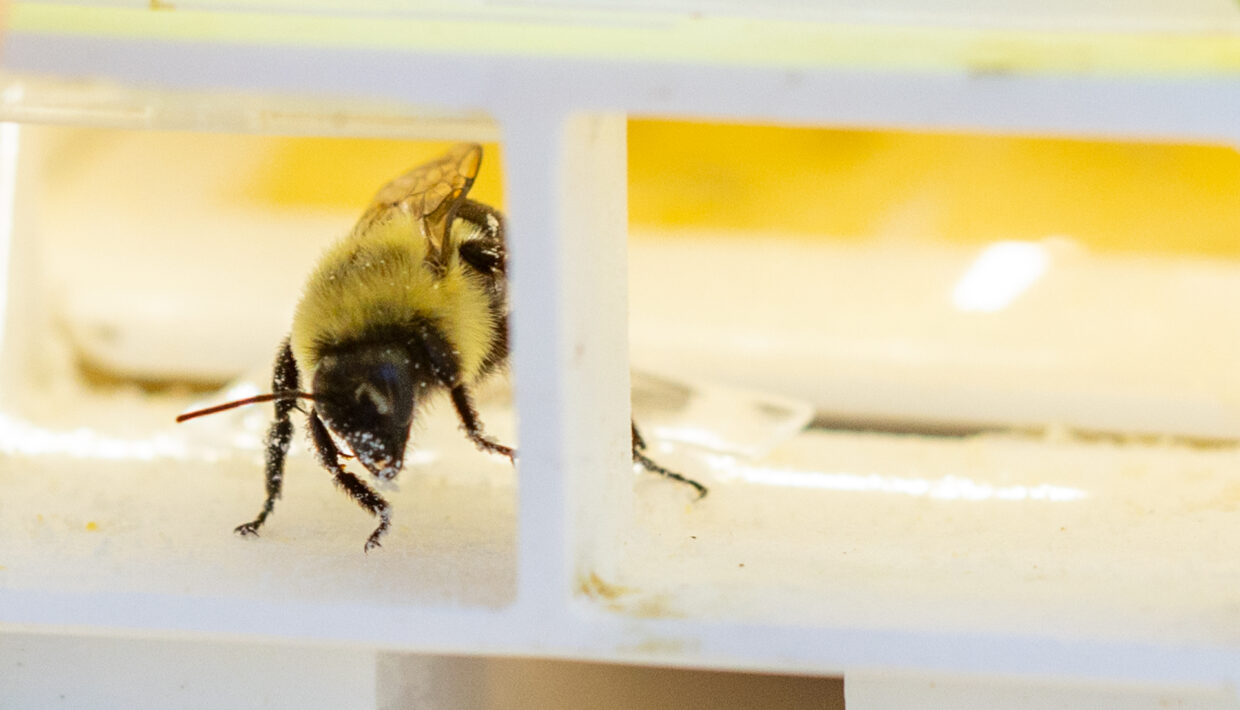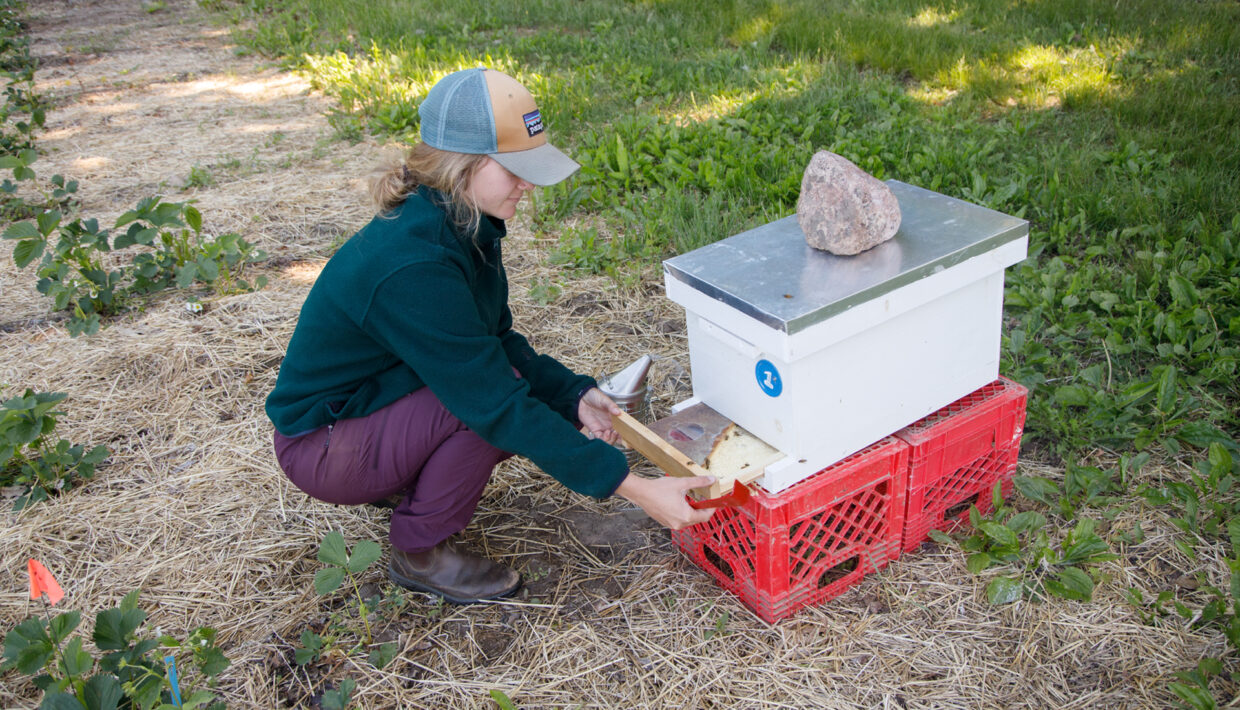Precision agriculture conjures up visions of satellites, computers, sensors, and other wonders of the electronic age. But a new fungicide application technology rolling out across the America’s main berry growing regions uses a slight variation of one of the world’s oldest agricultural practices, beekeeping. It’s possibly the most precise application technology yet. “The process is called bee vectoring,” says Dr. Sue Willis Chan, manager of the University of Guelph’s 2020 Bee Vectoring Project. “Bees pick up small particles that contain biocontrol agents as they leave their hive and disseminate them to flowering crops. It works for strawberries, raspberries, apples, coffee, cucumbers, and potentially sunflowers and some canola too. Essentially, it can be used with any flowering crop that uses bees for pollination.”
Plant protection from flower to flower
The concept, first pioneered at the University of Guelph in Ontario back in the 1990s, is simple. Biocontrol agents are diluted in powder-based diluent and placed in dispensers. Some dispensers are cartridges designed to snap into specially constructed bumblebee hives, others are mounted onto honeybee hives.

Dr Sue Willis Chan, head of the Bee Vectoring project at the University of Guelph, believes the process is applicable to all crops where bees are used for pollination.
The bees pass through them as they leave the hives and the diluent clings to their body hairs. It’s carried with them when they fly off to collect pollen or nectar from flowers. Once they land it rubs off onto the flower, where it protects the blossom from pathogens like botrytis (grey mold). Other pollinators can then spread it further as they flit from flower to flower.
No disbenefit for the pollinators
Biocontrol agents work really well in controlled greenhouse environments, Willis Chan says, but it’s less known how they’ll work outdoors in crops like strawberries. Chan’s study with both beekeepers and berry producers will determine how well it does and will make sure the products being used won’t adversely affect wild bees and other pollinators.
Currently one company, Bee Vector Technology (BVT) based in Mississauga, Ontario, has a system registered by the EPA for field use in America’s main berry growing regions. Only a few growers were able to try it out in 2020, but BVT’s CEO Ashish Malik expects it will be widely available in 2021. They plan to have it registered in Switzerland and Mexico for 2021 and hope to get approval for the European Union and Canada.
“Our system uses bees to disrupt the grey mold cycle by delivering a strain of Clonostachys rosea, BVT-CR7 combined with a diluent called Vectorite, directly to the source of the infection on the flowers,” Malik says. “Since it’s very targeted, it’s very efficacious. You’re not wasting any product. We’ve been able to demonstrate that you can reduce the amount of product over the course of the blooming season by up to 98%. Plus, CR7 is a biological product, it can be used in either conventional or organic berry production.”

The product is placed in special cartridges that the bees have to pass through as they leave the hive. Su Willis Chan says that the process works for any crops that use bees for pollination.
Bees and farmers working together
Many pluses. The biggest advantage to bee vectoring is its simplicity; it’s only a slight variation from what producers using bees for pollination are already doing. But it cuts down on the urgency to spray fungicides on a crop like strawberries every 7 to 14 days to control grey mold. Since CR-7 is biological, it isn’t one of the products that contribute to strawberries’ notorious position on the “Dirty Dozen” list.
“This means that bee vectoring should reduce the machinery, fuel, water, and manhour costs associated with spraying fungicides on these crops,” Willis Chan says. “The bees are the ones doing all the work. Biocontrol products are expensive and quite short lived; but bees aren’t delivering the biocontrol agents willy nilly, they’re applying it directly, continuously, and where it needs to be.”
Bee Vectoring can reduce costs for machinery, fuel, water and labour.
Sue Willis Chan
BVT’s Vectorite cartridges have to be replaced every fourth day throughout the flowering window but bees use the product so efficiently that the price is competitive, on a per acre basis, to conventional fungicide spray programs. It offers solid economic returns, Malik says. Growers have reported 28 to 30 percent higher yields in blueberries because the diameter of berries on treated plants are 10 to 11 percent bigger than those in conventional spray programs.
Another big advantage is that biocontrol products applied by bees have a zero-re-entry interval (REI). Workers can be in the field harvesting or performing other tasks while the bees are working. That’s huge for strawberry growers who must continually balance the need to have workers in the field harvesting berries around conventionally applied products’ 4-hour to 2-day REIs.

Wiilis Chan’s study is testing a variety of honeybee hive modifications for bee vectoring. BVT is the only company that has received approval by the EPA to deliver biocontrol agents via bee vectoring for field crops in the United States.
No panacea. Willis Chan cautions producers not to expect bee vectoring to be a panacea since it’s only useful for diseases and insects that affect blossoms. It’s not a solution for leaf, stem or root diseases. There is also some variability between hives. Bees are smart living creatures, she adds. Some hives spend a lot of time kicking the diluent out of the dispenser onto the ground in front of the hive.
Smart Bees
Another issue is that bees don’t like to forage in the rain. So, if you get into an extended period of rainy weather, they’ll be less likely to be carrying the biocontrol agent to the flowers. “I can see producers might develop a system that gives them the best of both worlds,” Willis Chan says. “Under a conventional system they could apply fungicides and insecticides with a sprayer prior to flowering and switch to bee vectoring once they start to flower. This eliminates any possibility of getting fungicide or insecticide residue on fruit because there is no fungicide applied during the flowering and fruit development period. Plus, producers will use much less fungicide overall; it might just hit the sweet spot.”
